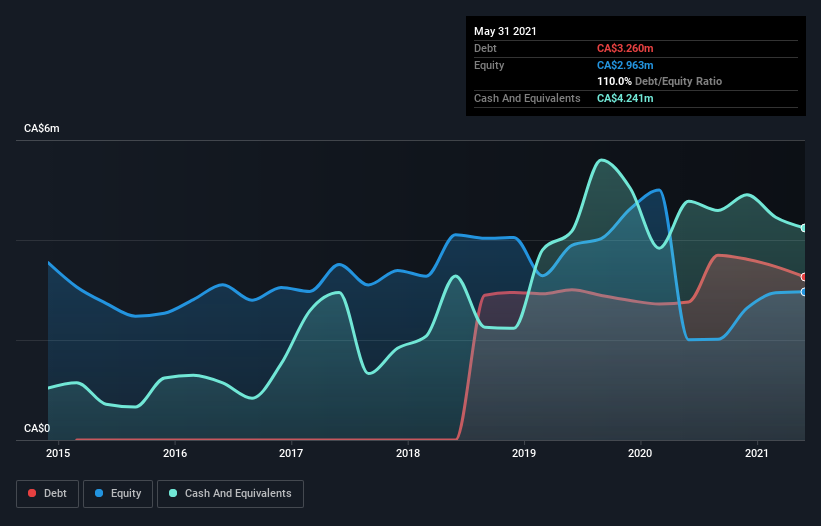Is Thermal Energy International (CVE:TMG) Using Debt In A Risky Way?

David Iben put it well when he said, 'Volatility is not a risk we care about. What we care about is avoiding the permanent loss of capital.' It's only natural to consider a company's balance sheet when you examine how risky it is, since debt is often involved when a business collapses. Importantly, Thermal Energy International Inc. (CVE:TMG) does carry debt. But is this debt a concern to shareholders?
Why Does Debt Bring Risk?
Generally speaking, debt only becomes a real problem when a company can't easily pay it off, either by raising capital or with its own cash flow. Ultimately, if the company can't fulfill its legal obligations to repay debt, shareholders could walk away with nothing. However, a more common (but still painful) scenario is that it has to raise new equity capital at a low price, thus permanently diluting shareholders. Of course, plenty of companies use debt to fund growth, without any negative consequences. The first step when considering a company's debt levels is to consider its cash and debt together.
See our latest analysis for Thermal Energy International
What Is Thermal Energy International's Net Debt?
You can click the graphic below for the historical numbers, but it shows that as of May 2021 Thermal Energy International had CA$3.26m of debt, an increase on CA$2.76m, over one year. However, its balance sheet shows it holds CA$4.24m in cash, so it actually has CA$980.4k net cash.

How Strong Is Thermal Energy International's Balance Sheet?
Zooming in on the latest balance sheet data, we can see that Thermal Energy International had liabilities of CA$4.77m due within 12 months and liabilities of CA$3.81m due beyond that. On the other hand, it had cash of CA$4.24m and CA$3.18m worth of receivables due within a year. So it has liabilities totalling CA$1.16m more than its cash and near-term receivables, combined.
Given Thermal Energy International has a market capitalization of CA$23.8m, it's hard to believe these liabilities pose much threat. But there are sufficient liabilities that we would certainly recommend shareholders continue to monitor the balance sheet, going forward. While it does have liabilities worth noting, Thermal Energy International also has more cash than debt, so we're pretty confident it can manage its debt safely. There's no doubt that we learn most about debt from the balance sheet. But it is Thermal Energy International's earnings that will influence how the balance sheet holds up in the future. So if you're keen to discover more about its earnings, it might be worth checking out this graph of its long term earnings trend.
In the last year Thermal Energy International had a loss before interest and tax, and actually shrunk its revenue by 28%, to CA$15m. That makes us nervous, to say the least.
So How Risky Is Thermal Energy International?
While Thermal Energy International lost money on an earnings before interest and tax (EBIT) level, it actually booked a paper profit of CA$198k. So taking that on face value, and considering the cash, we don't think its very risky in the near term. Until we see some positive EBIT, we're a bit cautious of the stock, not least because of the rather modest revenue growth. There's no doubt that we learn most about debt from the balance sheet. But ultimately, every company can contain risks that exist outside of the balance sheet. For example Thermal Energy International has 5 warning signs (and 1 which doesn't sit too well with us) we think you should know about.
At the end of the day, it's often better to focus on companies that are free from net debt. You can access our special list of such companies (all with a track record of profit growth). It's free.
Valuation is complex, but we're here to simplify it.
Discover if Thermal Energy International might be undervalued or overvalued with our detailed analysis, featuring fair value estimates, potential risks, dividends, insider trades, and its financial condition.
Access Free AnalysisThis article by Simply Wall St is general in nature. We provide commentary based on historical data and analyst forecasts only using an unbiased methodology and our articles are not intended to be financial advice. It does not constitute a recommendation to buy or sell any stock, and does not take account of your objectives, or your financial situation. We aim to bring you long-term focused analysis driven by fundamental data. Note that our analysis may not factor in the latest price-sensitive company announcements or qualitative material. Simply Wall St has no position in any stocks mentioned.
Have feedback on this article? Concerned about the content? Get in touch with us directly. Alternatively, email editorial-team (at) simplywallst.com.
About TSXV:TMG
Thermal Energy International
Engages in the development, engineering, and supply of pollution control products, heat recovery systems, and condensate return solutions in North America, Europe, and internationally.
Flawless balance sheet and slightly overvalued.
Market Insights
Community Narratives



